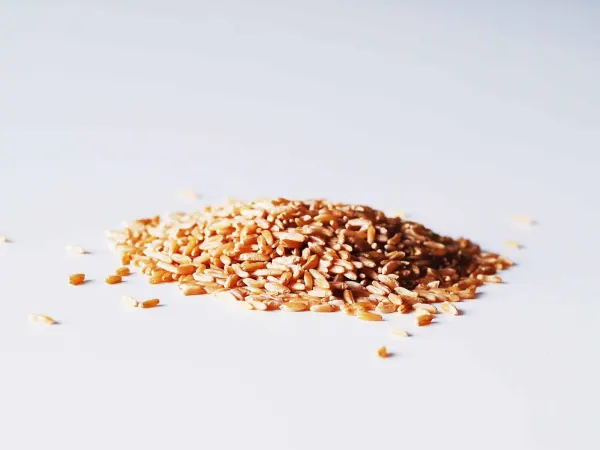Khorasan Wheat (Kamut)
Grain
Age Suggestion
6 months
Iron-Rich
Yes
Common Allergen
Yes

When can babies eat khorasan wheat (Kamut)?
Khorasan wheat may be introduced as soon as baby is ready to start solids, which is generally around 6 months of age.
Where does khorasan wheat come from?
Like other ancient grains, khorasan wheat originated in the fertile lands around the Mediterranean Sea, where humans have been cultivating grasses as a food source for thousands of years. Khorasan wheat is part of the durum family, and its popularity has grown in recent years, thanks in part to its higher protein and nutrient content than the standard, ubiquitous highly-refined wheat. You may know khorasan wheat as Kamut, which is a trademarked name from one company that sources the grain.
Videos
Is khorasan wheat healthy for babies?
Yes. Khorasan wheat is rich in carbohydrates to provide quick energy and fiber to help baby’s gut microbiome flourish and balance blood sugar levels. It’s also packed with iron, selenium, and zinc—essential nutrients for healthy blood, cognitive development, and thyroid health. Khorasan wheat also has ample magnesium, B-vitamins, and copper.
★ Tip: Purchasing khorasan wheat in bulk is typically more affordable, and it keeps well in an airtight container in a dark, cool storage area like a pantry.
Is khorasan wheat a common choking hazard for babies?
No. Khorasan wheat is not a common choking hazard, although individual grains do pose a risk of aspiration, which occurs when food or fluid is breathed into the airway, but does not block it. To reduce the risk, serve khorasan wheat as porridge, make finger food by flattening the cooked grains with the back of a fork, or mix cooked khorasan wheat into sauce or another soft, scoopable food. Because they are small, round, and don’t dissolve easily with saliva, puffed khorasan wheat poses a choking risk for babies. As always, make sure you create a safe eating environment and stay within arm’s reach of baby during meals. For more information on choking, visit our sections on gagging and choking and familiarize yourself with the list of common choking hazards.
Is khorasan wheat a common allergen?
Yes. Khorasan wheat is a type of wheat, and wheat is one of the most common food allergens in children. Fortunately, two-thirds of children outgrow the allergy by their 12th birthday.
It is important to note that wheat allergy is not the same as celiac disease. While a wheat allergy may be outgrown, celiac disease requires a strict, lifelong gluten-free diet and lifestyle. A gluten “allergy” is typically a misnomer, often in reference to celiac disease.
Individuals with Oral Allergy Syndrome (also known as pollen food allergy syndrome) may be sensitive to wheat, particularly those who are allergic to grass pollen. Oral Allergy Syndrome typically results in short-lived itching, tingling, or burning in the mouth. It is unlikely to result in a dangerous reaction.
While rare, some individuals have a condition known as wheat-dependent, exercise-induced anaphylaxis, which can result in a severe allergic reaction if the person exercises within a few hours after eating wheat. These patients should avoid eating wheat in the four hours before strenuous activity.
Wheat and other gluten-containing grains have been reported in some cases of food protein-induced enterocolitis syndrome, also known as FPIES. FPIES is a rare and delayed allergy to food protein which causes the sudden onset of repetitive vomiting and diarrhea to begin a few hours after ingestion of the food trigger. Left untreated, the reaction can result in significant dehydration. Fortunately, most cases resolve completely by early childhood. To learn more about FPIES, read our post on Food Allergens and Babies.
If you are concerned that baby may be allergic to wheat, talk to a pediatric health care provider before introducing wheat at home. As you would when introducing any new food, start by offering a small quantity for the first few servings and watch closely for any signs of an allergic reaction. If there is no adverse reaction, gradually increase the amount over future meals.
Does khorasan wheat have gluten?
Yes. Khorasan wheat contains gluten, a type of protein in wheat and other grains such as barley, rye, and gluten-contaminated oats. As long as a child does not have wheat allergy, celiac disease, or non-celiac gluten sensitivity, gluten is perfectly safe and healthy for babies to consume. Gluten becomes problematic for individuals with celiac disease, an autoimmune disease, characterized by damage of the small intestine when gluten is consumed. Some individuals may be sensitive to gluten, but may not have an allergy or celiac disease. In some cases, this may be non-celiac gluten sensitivity. However, gluten-containing grains can also contain certain carbohydrates that are difficult for some individuals to digest, which can be mistaken for allergies or intolerance to gluten. Talk to a pediatric health care provider if you are concerned about issues related to gluten and digestion.
Can khorasan wheat help babies poop?
Yes. Khorasan wheat offers good amounts of fiber and resistant starches that, in combination with a balanced and varied diet, help support overall digestive health and bowel regularity. Remember that pooping patterns can vary significantly from baby to baby. If you have concerns about baby’s pooping and digestive function, talk to your pediatric healthcare provider.
When can babies have puffed khorasan wheat or puffed kamut?
Because puffed khorasan wheat is small, round, and doesn’t dissolve as easily with saliva (like puffs made specifically for infants), it is best to wait to serve puffed khorasan wheat until a child is at least 18 months old. Toddlers trying this food for the first time should be able to follow simple instructions and a caregiver’s direct modeling (i.e., “Watch me bite!”) and should not be overstuffing their mouths. Note that stale puffed khorasan wheat poses a higher choking risk, as it can become firmer and chewier.
To model how to eat this food safely, start by telling your child: "This is a tricky one. Watch me.” Then, demonstrate by placing the puffed grain in-between your front teeth. Hold the puff between your teeth and exaggerate moving it to your molars with your tongue. Chew with your mouth open (you can even demonstrate by opening and closing your hands at the same time). Once you have chewed well, open your mouth to show the child how it has been broken down. Demonstrate a couple of times before offering the child a single puffed grain to do the same. The child may spit the puffed grain out as they get used to the texture. If it goes well, offer one or two more at a time (but never more) to keep the pace slow. Toddlers may hold the puffed khorasan wheat in their mouth, waiting for it to soften, before swallowing, and that’s totally fine. Just make sure their mouth is clear and empty of food before the child gets down from their chair and is walking around again.
How do you prepare khorasan wheat for babies with baby-led weaning?
Every baby develops on their own timeline, and the suggestions on how to cut or prepare particular foods are generalizations for a broad audience.
6 months old+:
Make porridge with khorasan wheat, and experiment with nutrient-rich cooking liquids like buttermilk, coconut milk, or vegetable stock and seasonings like butter or ghee, cinnamon, or finely ground-up tree nuts. To serve khorasan wheat as finger food, mix the cooked wheat with ground meat or mashed vegetables to make balls or fritters—shapes that are easier for baby to grab. Alternatively, serve strips of pancakes or waffles made with khorasan wheat flour. Khorasan wheat bread, pasta, and other products made with khorasan wheat flour prepared in an age-appropriate way are also great ways to introduce the grain.
9 months old+:
Offer porridge, fritters, or meatballs made with cooked khorasan wheat. When you see signs of the pincer grasp (where the thumb and index finger meet), feel free to share grain salads with baby. Flattening the grains with the back of a fork can help them stick together, which makes it easier for babies to self-feed. Alternatively, mix khorasan wheat salads into a soft, scoopable food like mashed vegetables or yogurt. You can also serve pancakes or waffles made with khorasan wheat flour, either in strips for practice taking bites or in bite-sized pieces to promote the pincer grasp.
12 months old+:
Offer cooked khorasan wheat, either as finger food, as part of a grain salad, or mixed into other soft, scoopable foods. If the child struggles to pick up the grains on their own, flattening khorasan wheat with the back of a fork can help them stick together and make them easier to pick up. Serve bread, pancakes, pasta, and other products made with khorasan wheat flour.
18 months old+:
Serve cooked khorasan (either the whole grain or products made from khorasan flour) as desired, either as finger food or for practice with an age-appropriate utensil. At this age, many toddlers can manage puffed khorasan wheat. Because these puffed grains pose a higher choking risk, make sure to coach the child how to eat them and only serve in a safe eating environment.
Mix up mealtime with ideas from our guide 100 Dinners for Babies & Toddlers.
Written by
Expert Tips Delivered to Your Inbox
Sign up for weekly tips, recipes and more!
The content offered on SolidStarts.com is for informational purposes only. Solidstarts is not engaged in rendering professional advice, whether medical or otherwise, to individual users or their children or families. No content on this site, regardless of date, should ever be used as a substitute for direct medical advice from your doctor or your medical or health professional, nutritionist, or expert in pediatric feeding and eating. By accessing the content on SolidStarts.com, you acknowledge and agree that you are accepting the responsibility for your child’s health and well-being. In return for providing you with an array of content “baby-led weaning” information, you waive any claims that you or your child may have as a result of utilizing the content on SolidStarts.com.








